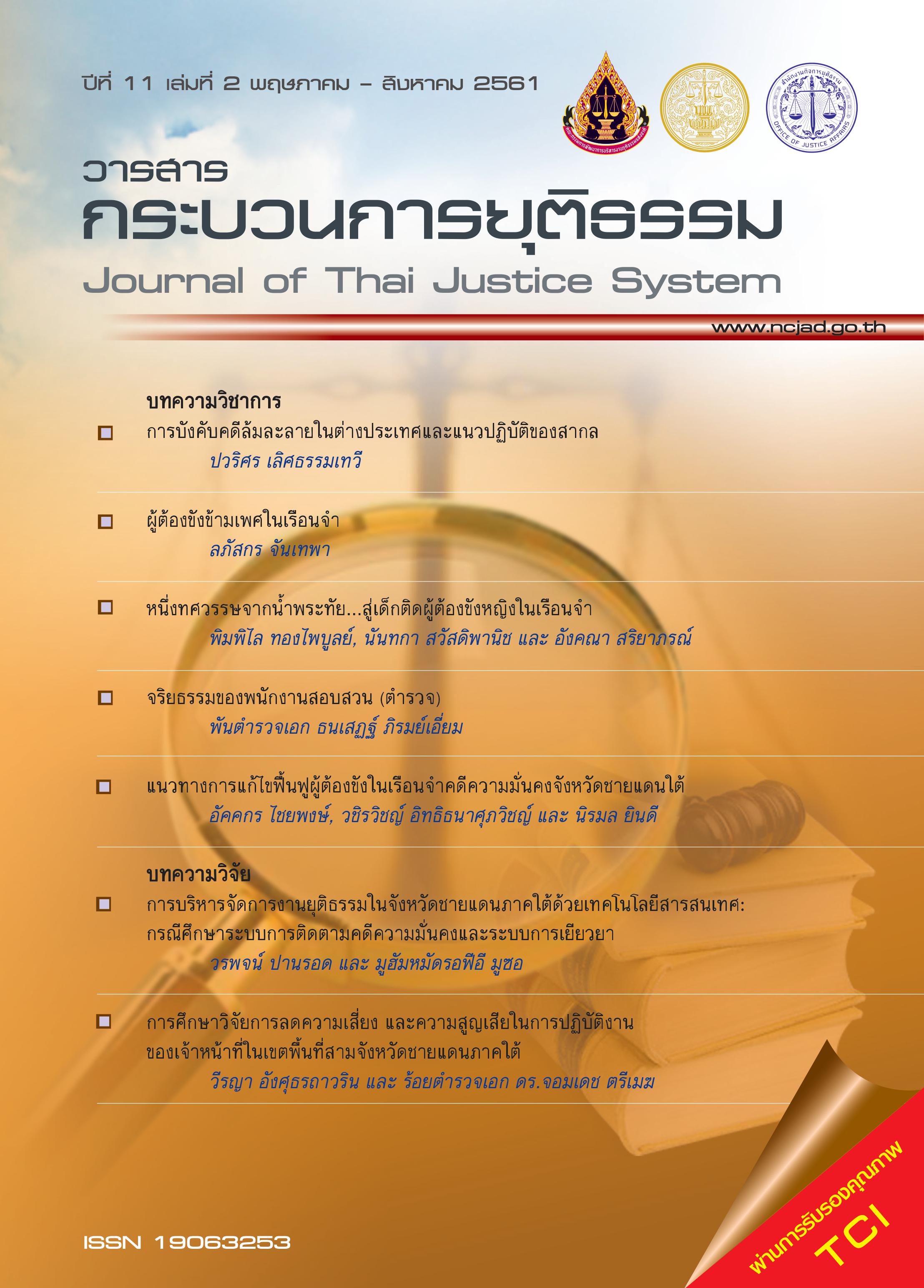การบังคับคดีล้มละลายในต่างประเทศและแนวปฏิบัติของสากล
Main Article Content
บทคัดย่อ
การแก้ไขปัญหาการล้มละลายเป็นประเด็นสำคัญที่แสดงให้เห็นถึงความยากง่ายในการเข้าไปประกอบธุรกิจของนักลงทุน ซึ่งธนาคารโลกได้จัดทำการศึกษาวิเคราะห์ไว้ในรายงานผลการวิจัย
เรื่อง “Doing Business” เพื่อประกอบการตัดสินใจของนักลงทุนและการให้สินเชื่อของสถาบันการเงิน
โดยประเทศไทยมีอัตราการได้รับชำระหนี้คืนร้อยละ 67.7 ถูกจัดให้อยู่ในลำดับที่ 23 ของโลกในเรื่องการแก้ไขปัญหาการล้มละลายในปี ค.ศ. 2016 ถือว่าเป็นอัตราที่ต่ำเมื่อเปรียบเทียบกับประเทศอื่น ๆ อาทิ สหรัฐอเมริกา อังกฤษ ญี่ปุ่นและมาเลเซีย ปัจจัยสำคัญที่ส่งผลต่อประสิทธิภาพในการแก้ไขปัญหาการล้มละลาย คือ กระบวนการภายในของการล้มละลายที่ส่งผลต่อตัวชี้วัดในเรื่องของอัตราการได้รับชำระหนี้คืน และความสามารถในการรวบรวมทรัพย์สินของเจ้าพนักงานพิทักษ์ทรัพย์เป็นประเด็นสำคัญ ที่ต้องพิจารณาเป็นลำดับแรก
บทความนี้กล่าวถึง ระบบกฎหมายล้มละลายของต่างประเทศ ได้แก่ สหรัฐอเมริกา อังกฤษ ญี่ปุ่นและมาเลเซีย และการศึกษากรอบของธนาคารโลกในเรื่อง “Doing Business” ซึ่งจัดอันดับความยากง่าย ในการเข้าไปประกอบธุรกิจในแต่ละประเทศโดยกล่าวถึงเรื่องการแก้ไขปัญหาล้มละลายว่าเป็นปัจจัยสำคัญประการหนึ่งที่วัดระดับความยากง่ายในการประกอบธุรกิจ และศึกษาวิเคราะห์กรณีคณะกรรมการธิการสหประชาชาติว่าด้วยกฎหมายการค้าระหว่างประเทศ (UNCITRAL) ซึ่งมีการวางหลักการเกี่ยวกับกฎหมายล้มละลายในลักษณะที่เป็นกฎหมายเอกภาพ อย่างไรก็ตาม ทั้งสองกรณี มิได้กล่าวถึงกระบวนการภายในเรื่องการบังคับคดีล้มละลาย
จากการศึกษาวิเคราะห์ประเทศกลุ่มตัวอย่าง 4 ประเทศ สรุปได้ว่าทุกประเทศมีสถิติการจัดอันดับการแก้ไขปัญหาการล้มละลายในระดับที่สูงกว่าประเทศไทย โดยทุกประเทศที่นำมาศึกษาวิเคราะห์ข้างต้นยังพบว่า มีความเหมือนกันในสาระสำคัญเกี่ยวกับกระบวนการภายในในการสืบค้นทรัพย์สินของบุคคล กล่าวคือ ทุกประเทศที่นำมาศึกษามีระบบฐานข้อมูลกลางจัดไว้สำหรับการสืบค้นและตรวจสอบข้อมูลทรัพย์สินของบุคคล ส่งผลให้ง่ายต่อการสืบค้นข้อมูลทรัพย์สินของบุคคล และมีการเชื่อมโยงข้อมูลระหว่างหน่วยงานทั้งภาครัฐและเอกชนผ่านการใช้เลขประกันสังคม นอกจากนี้ การจัดการทรัพย์สินของบุคคลล้มละลายในประเทศสหรัฐอเมริกาและญี่ปุ่นยังมีวิธีการอื่นนอกเหนือจากการขายทอดตลาด คือ การใช้วิธีการประเมินมูลค่าทรัพย์สินทางปัญญามาปรับใช้กับการบังคับคดี
Article Details
ต้นฉบับที่ได้รับการตีพิมพ์ในวารสาร เป็นลิขสิทธิ์ของวารสารกระบวนการยุติธรรม แต่ความคิดเห็นที่ปรากฏในเนื้อหาของบทความในวารสารกระบวนการยุติธรรม ถือเป็นความรับผิดชอบของผู้เขียนแต่เพียงผู้เดียว
เอกสารอ้างอิง
ปวริศร เลิศธรรมเทวี. (2559). ปัญหากระบวนการรวบรวมและจัดการทรัพย์สินบุคคลล้มละลายของไทย. วารสารกฎหมาย คณะนิติศาสตร์ จุฬาลงกรณ์มหาวิทยาลัย, 34(2), หน้า 145-166.
ปวริศร เลิศธรรมเทวี. (2560). ข้อเสนอแนะการปรับปรุงกระบวนการรวบรวมและจัดการทรัพย์สินของบุคคลล้มละลายให้มีประสิทธิภาพ. วารสารกฎหมาย คณะนิติศาสตร์ จุฬาลงกรณ์มหาวิทยาลัย, 35(1) หน้า, 39-60.
ปวริศร เลิศธรรมเทวี และป่าน จินดาพล. (2560) หลักการ แนวคิด และทฤษฎีเกี่ยวกับระบบกฎหมายล้มละลาย. บทบัณฑิตย์, 73(1) หน้า 131-154.
Douglas G. Baird. Revisiting Auctions in Chapter II. The University of Chicago, Law & Economic Working Paper No. 7.
Junichi Matsushita. (2007). Japan’s Personal Insolvency Law. Texas International Law Journal, 42, p 765.
Karin S. Thorburn. (1997). Bankruptcy Auctions: Costs, debt recovery, and firm survival. PhD Thesis, Stockholm School of Economics.
L.P. Harrison III and Eric Stenshoel. (2014). Protecting the Rights of IP Licensors, Licensees in Bankruptcy. New York Law Journal, 15, at 1.
Leong Wai Hong. (2003). A Brief Outline on Malaysian Bankruptcy Law and Corporate Insolvency and Restructuring Procedures in Malaysia. Paper presented at the Lex Mundi Conference, San Francisco, September 2003.


